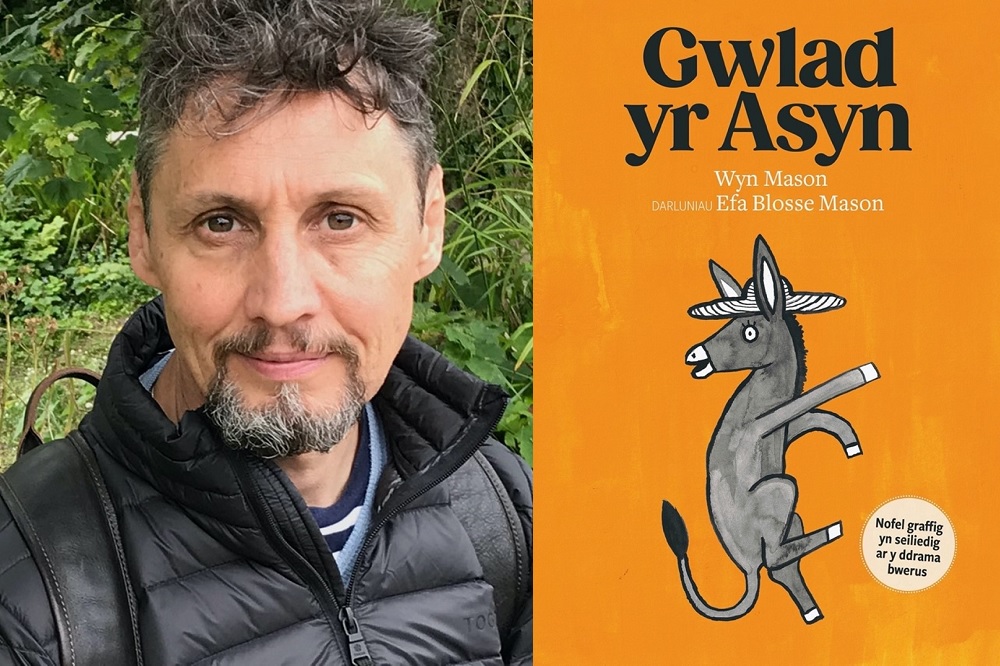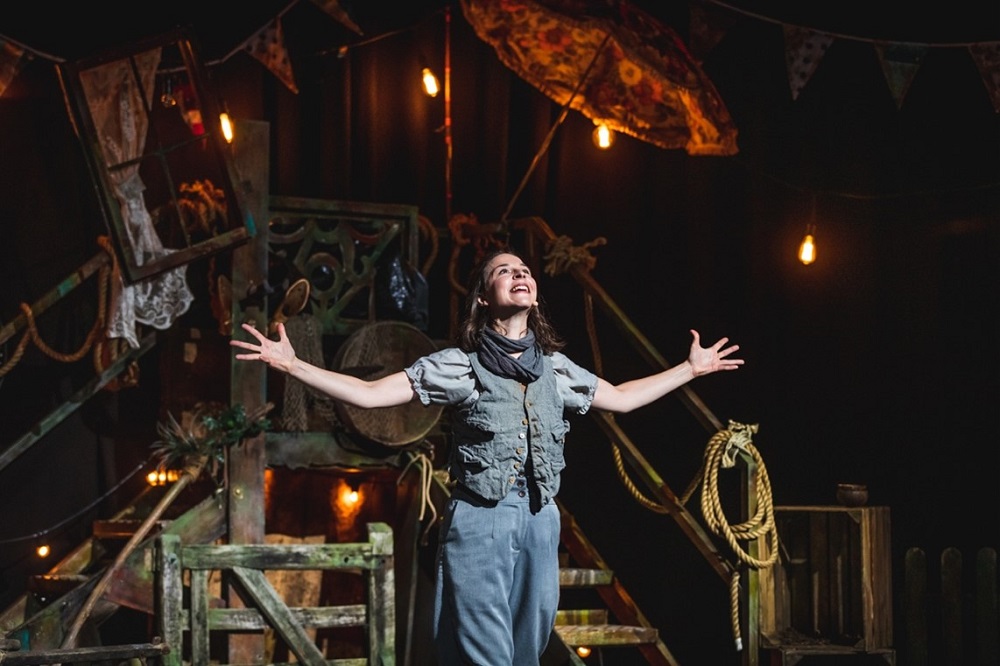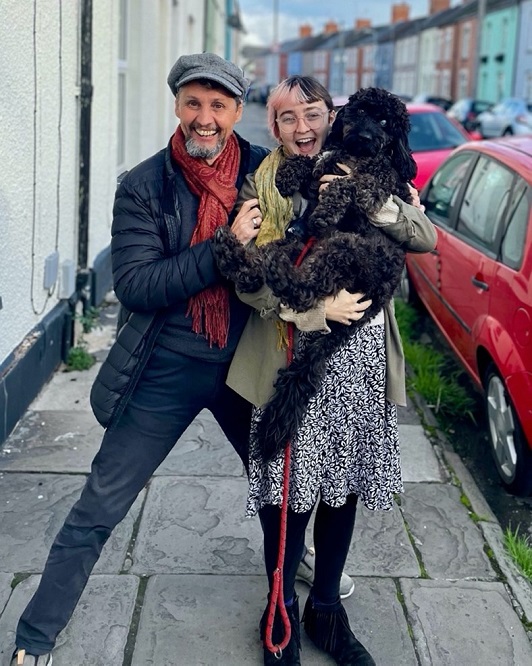On being a writer in Wales: Wyn Mason

Wyn Mason
The idea emerged during a stroll through Llandaff Fields, Cardiff. I was chatting with an old school friend, the novelist Gareth Evans, about my stage play, Gwlad yr Asyn (Donkelyand).
It’s a story of how an overly obedient donkey becomes rewilded. Gareth asked if I had considered adapting it into a graphic novel. No, I hadn’t. At the time, graphic novels were not on my radar.
I had enjoyed Beano and Tintin when I was a boy, but I’d left comics behind in childhood. My daughter, Efa, however, (who’s a film animator and illustrator) is an avid graphic novel reader. Wouldn’t it be wonderful if we collaborated?
I’m originally from a Fine Art background, and when Efa was a child I still used to paint fairly regularly, so she was brought up in an art practice household. We would always be drawing or painting or making up stories.
To collaborate on a graphic novel with her would be a way of returning to what we used to do together (she’s now in her mid-20s).
As soon as I arrived home I rang Efa and asked if she’d like to work on a graphic novel with me. Without hesitation, she said yes! I was thrilled.

Steep learning curve
I raided Efa’s graphic novel collection. The first one I read was Fun Home by Alison Bechdel, which is widely acknowledge to be an outstanding example. Immediately, I fell in love with the form. Bechdel’s ability to communicate complex ideas and feelings through combining text and images in creative and thought provoking ways was truely inspiring.
Once I’d worked my way through Efa’s collection, I raided the graphic novel section at Cardiff’s Central Library. My appreciation of the graphic novel aesthetic grew and grew.
But I knew nothing about how to write a graphic novel. I had a lot to learn.
I knew of Neil Gaiman, the famous comics writer, and wondered how he wrote his scripts. I found a website that presented his draft scripts alongside the completed, published comics pages, and set about studying these.
I had worked in film and television as a director for many years, so I’m familiar with screenplays, shotlists and storyboards. This background, as it turned out, along with my art practice and playwriting, provided me with a solid foundation for writing graphic novels. It was almost as if my career to date had been secretly leading me to this project.
I sat down to write the first page:
Panel 1
CAPTION: BECAUSE I’D BEEN BROUGHT UP IN A HOUSE AND TREATED AS A PERSON, I WAS FUNDAMENTALLY DIFFERENT FROM OTHER DONKEYS.
Fine. But what image could be placed alongside this text? This question, in my opinion, gets to the heart of the graphic novel asthetic: the art of combining text and images in engaging, meaningful ways. Writing a graphic novel involves answering this question over and over again.

ARI: (thinking) THIS SOUNDS FAMILIAR … MOZART, MAYBE?
Who’s it for?
I handed Efa the first ten pages of the script, and she skillfully brought them to life with her charming drawings.
The first thing that struck us was how different the story felt, now that it was presented pictorially.
The stage play is a donkey monologue. But it’s not performed by an actor dressed in donkey costume: the actor is a human being, dressed as a human, addressing the audience as if she were a donkey.
This design concept was adopted to encourage audience members to interpret the play allegorically: to read the story as a political allegory.
But in the graphic version, of course, the donkey characters are actual donkeys, with big ears, hooves and tails. The play was written for an adult audience, but now the same story felt like a children’s tale.
Adapting from one artform to another sometimes changes everything.
We sent our sample pages to Myrddin ap Dafydd at Gwasg Carreg Gwalch, Llanrwst. He thought the project looked promising, but was a little uncertain of the target readership. So he forwarded the pages to Ysgol Tryfan in Bangor to see how school children of different ages would respond.
When the written feedback returned it was positive. Phew! And it was clear that the samples were appreciated mostly by 11–13 year olds.
The teachers also reported that, because they had been absent from school during the Covid lockdowns, some pupils’ Welsh language reading skills had deteriorated significantly.
Therefore having a Welsh language graphic novel might be useful as a way of enticing rusty readers back into the habit of reading in Welsh.
Gwasg Carreg Gwalch’s bid to the Welsh Book Council for financial support was successful.
Cottage industry
Efa’s sample pages had been drawn digitally, but by now she was disatisfied with them. She thought the style was too lifeless and mechanical. So she decided to hand-paint the entire book. This would give it a more intimate feel, but it would take her far longer to complete.
She created the pictures, using gouache paint on A4 paper. Then she would bring the images to my house for scanning. Efa then completed the pages in Photoshop: adding panels, captions, speech and thought bubbles, etc.
Scanning the images into the computer was satisfying because it allowed me to see the book taking shape image by image. And as I scanned I marvelled at the home-made nature of our enterprise. I hadn’t imagined that the experience of publishing my first book would be so hands on.
Efa completed the entire book within six months, all 190 pages. It took tremendous effort.
During this period we worked closely together. We did our best to stick to our designated roles of writer and illustrator, but inevitably the collaboration was coloured by our father/daughter relationship.
She felt at ease with giving me feedback on my writing, and similarly I gave feedback on her work. Most of the time we would agree and took each other’s feedback on board, but there were a few heated debates. Nevertheless a fruitful artistic collaboration has emerged.

Graphic novels / nofelau graffig
Graphic novels started in the USA in the 1970s and ’80s, and have grown in popularity enormously over the past twenty years.
By now most bookshops have a graphic novel section. However, the form hasn’t made much headway within Welsh language publishing – very few have been published to date.
I hope Gwlad yr Asyn will be enjoyed by readers, that it will help build appreciation of the form, and inspire other Welsh language authors to turn their hand to writing graphic novels.
Gwlad yr Asyn is published by Gwasg Carreg Gwalch and can be bought here or from good bookshops. More details about its launch on Saturday 3 December can be found here.
Support our Nation today
For the price of a cup of coffee a month you can help us create an independent, not-for-profit, national news service for the people of Wales, by the people of Wales.




